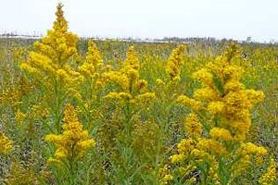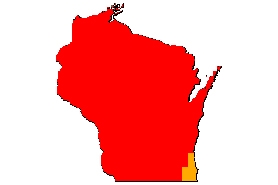Seaside goldenrod
(Solidago sempervirens)
Perennial goldenrod tolerant of standing water, drought and saline soils.
Other names for this plant include:
- Common names: salt marsh goldenrod, evergreen goldenrod
Classification in Wisconsin: Prohibited/Restricted (Restricted in Restricted in Kenosha, Milwaukee, and Racine counties; Prohibited elsewhere)
- Ecological Threat
-
- Invades wetlands, prairies, dunes, marshes, lakeshores, and roadside ditches.
- Tolerant of extreme conditions (standing water, drought, high saline) and various soils.
- It is sold as an ornamental for wildflower gardens.
- Prolific seed producer.
- This plant has numerous varieties and cultivars.
- Identification
-
Leaves & stems: Perennial plant base is woody. Plants have narrow basal leaves. Leaves on the stem are alternate and sessile (attaching without leaf stalks). Stalks are thick and fleshy with wings.
Flowers: Deep yellow-golden colored composite flowers have disk and ray florets. The inflorescence is pyramidal. Flowering occurs from top to bottom.
Fruits & seeds: Prolific seed producer.
Roots: Thick, fleshy, spaghetti-like roots.
Similar species: Numerous goldenrods (Solidago spp.) are native to Wisconsin.
- Distribution
-
See the reported locations of seaside goldenrod in Wisconsin.
Do you know of additional populations? Please send us a report.
- Control
-
Use an herbicide that contains picloram to treat. Spray each goldenrod plant with the herbicide. Wet each plant thoroughly until the goldenrod is saturated, but not to the point where the herbicide drips. Allow one growing season to pass before mowing the area. Please do not disturb or try to remove the plants during this time.
- Resources
- Sources for content:
- Stephen H. Brown & Kim Cooprider, University of Florida - Extension. 2010. Fort Myers, Florida



